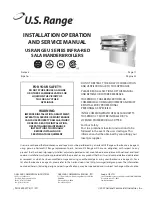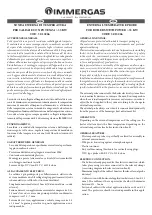
47
•
Remove the direct spark igniter and the flame
sensor.
•
Remove the three (3) T-25 screws holding the front
burner flange in place to gain access to the burner.
•
The burner can now be pulled horizontally out of
the heat exchanger cavity.
•
Use care to prevent damage to the knitted metal
fiber of the burner surface.
•
Wash the burner with water, such as a garden
hose. Never wipe or brush the surface of the
burner.
•
For optimal results immerse the burner port area in
a solution of dishwashing detergent and hot water.
DO NOT use chlorine based solvents or cleaning
agents on the burner. Allow the burner to remain in
the solution for a short period of time to remove,
dust, dirt and oil or grease laden contaminants.
•
Rinse the burner thoroughly with clean water to
remove any residue from the detergent cleaner
•
The burner should be air dried after removal from
the cleaning solution and rinsing.
•
Check all gaskets and replace as necessary.
Gaskets affected by heat will not reseal properly
and must be replaced.
•
Replace the burner in the reverse order that it was
removed.
NOTE
When the combustion air fan is removed for any reason, the
inlet to the burner must be covered to prevent further foreign
objects from falling into the burner. Always look inside the
burner to check for dents. Do not place a burner back into
operation if the inner distribution screen has been dented
during the service operation, call the factory for
recommendations. Use care when removing and handling
the burner, Sharp objects or impact may damage or tear the
metal fiber surface rendering the burner unfit for service.
11.8
COMBUSTION AND VENTILATION AIR
Check frequently to be sure that the flow of combustion air to
the appliance is not obstructed unless air is piped directly to
the heater. Combustion air must be provided to the
mechanical room with openings sized per the requirements
of the current B149 or National Fuel Gas Code. The
DynaMax is setup to allow outdoor combustion air to be
connected directly to the appliance.
11.9
CONTROL CIRCUIT VOLTAGE
This appliance uses a transformer to supply a low voltage
control circuit. The voltage on the secondary side should be
24 to 28VAC when measured with a voltmeter. A secondary
voltage of 21VAC or less supplied to 24VAC components
may cause operational problems.
11.10 COMBUSTIBLE MATERIALS
CAUTION
Keep appliance clear from combustible materials; do not
store GASOLINE and other flammable vapors and liquids in
the proximity of the appliance.
11.11 FREEZE PROTECTION FOR INDOOR &
OUTDOOR INSTALLATIONS
Installations are not recommended in areas where the
danger of freezing exists. Proper freeze protection must be
provided for appliances installed outdoors, in unheated
mechanical rooms or where temperatures may drop to the
freezing point or lower. If freeze protection is not provided for
the system, a low ambient temperature alarm is
recommended for the mechanical room. Damage to the
appliance by freezing is non-warrantable.
•
Location - Heating boilers, hot water supply boilers or
water heaters must be located in a room having a
temperature of at least 40ºF (5ºC).
•
Caution - A mechanical room operating under a
negative pressure may experience a downdraft in the
flue of an appliance that is not firing. The cold outside
air may be pulled down the flue and freeze a heat
exchanger. This condition must be corrected to provide
adequate freeze protection.
•
Freeze protection for the appliance using an indirect coil
can be provided by using hydronic system antifreeze.
Follow the manufacturer’s instructions. DO NOT use
undiluted or automotive type antifreeze.
•
Shut-down and draining - If for any reason, the unit is
to be shut off in a space where danger of freezing
exists, the following precautionary measures must be
taken:
o
Shut off gas supply.
o
Shut off water supply.
o
Shut off electrical supply.
o
Drain the main exchanger and the brazed plate
heat exchanger, if supplied, completely.
o
Ensure that the pump and connecting piping are
fully drained.
11.12 FREEZE PROTECTION FOR A HEATING
BOILER SYSTEM (Optional)
•
Use only properly diluted inhibited glycol antifreeze
designed for hydronic systems. Camus recommends
using a 30/70 mixture of glycol antifreeze to water. DO
NOT exceed a mixture of 50/50.
•
Follow the instructions from the antifreeze manufacturer.
Quantity of antifreeze required is based on total system
volume including expansion tank volume.
•
Antifreeze is denser than water and changes the
viscosity of the system. The addition of antifreeze will
decrease heat transfer and increase frictional loss in the
boiler and related piping.
Where antifreeze has been
used, to maintain the temperature rise across the
appliance confirm that the recommended GPM for pure
water has been increased by 15% and the head loss by
20%.
•
Local codes require a back flow preventer or actual
disconnect from city water supply when antifreeze is
added to the system.
•
When filling or topping-up the system with water mixed
with the antifreeze always used distilled or RO (reverse
osmosis) water. This will prevent the reaction of the
water with antifreeze which can create sludge.
Summary of Contents for DMC 753
Page 20: ...16 ...
Page 63: ...59 PART 14 EXPLODED VIEW PARTS LIST DYNAMAX WALL HUNG ...
Page 64: ...60 DYNAMAX FLOOR MOUNT ...
Page 71: ...67 PART 15 ELECTRICAL DIAGRAMS 15 1 DM 80 250 INTERNAL WIRING DIAGRAM WALL HUNG MODELS ...
Page 72: ...68 15 2 DM 210 750 INTERNAL WIRING DIAGRAM FLOOR MOUNT MODELS ...
















































